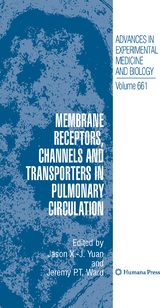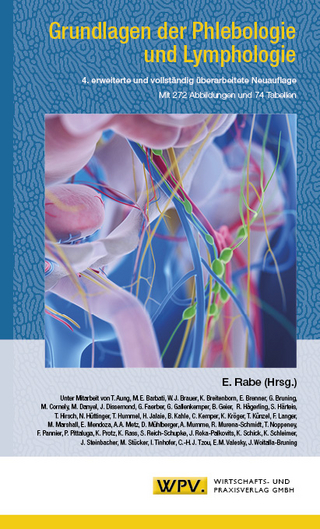Membrane Receptors, Channels and Transporters in Pulmonary Circulation
Humana Press Inc. (Verlag)
978-1-60761-499-9 (ISBN)
The overall goal was to explore the mechanisms by which specific receptors, channels and transporters contribute to pulmonary vascular function in both health and disease, and how this knowledge may lead to novel interventions in lung dysplasia, pulmonary edema, lung injury, and pulmonary and systemic hypertension to reduce and prevent death from lung disease.
Membrane Receptors, Channels and Transporters in Pulmonary Circulation is divided into six parts. Part 1 (Ion Channels in the Pulmonary Vasculature: Basics and New Findings) is designated for basic knowledge and recent findings in the research field of ion channels in pulmonary circulation. There are five chapters in Part I discussing the function, expression, distribution and regulation of various ion channels present in pulmonary vascular smooth muscle cells and how these channels are integrated to regulate intracellular Ca2+ and cell functions. Part II (TRP Channels in the Pulmonary Vasculature: Basics and New Findings) is composed of five chapters that are exclusively designed to discuss the role of a recently identified family of cation channels, transientreceptor potential (TRP) channels, in the regulation of pulmonary vascular tone and arterial structure. Part III (Pathogenic Role of Ion Channels in Pulmonary Vascular Disease) includes four chapters that discuss how abnormal function and expression of various ion channels contribute to changes in cell functions and the development of pulmonary hypertension. Part IV (Receptors and Signaling Cascades in Pulmonary Arterial Hypertension) consists of five chapters devoted to the role of bone morphogenetic protein receptors, Notch receptors, serotonin receptors, Rho kinase and vascular endothelial growth factor receptors in the development of pulmonary arterial hypertension. Part V (Receptors and Transporters: Role in Cell Function and Hypoxic Pulmonary Vasoconstriction) includes four chapters designed to illustrate the potential mechanisms involved in oxygen sensing and hypoxia-induced pulmonary vasoconstriction and hypertension. Part VI (Targeting Ion Channels and Membrane Receptors in Developing Novel Therapeutic Approaches for Pulmonary Vascular Disease) consists five chapters which discuss the translational research involving on membrane receptors, channels and transporters, including their potential as novel drug targets.
We hope that Membrane Receptors, Channels and Transporters in Pulmonary Circulation will allow readers to foster new concepts and new collaborations and cooperations among investigators so as to further understand the role of receptors, channels and transporters in lung pathophysiology. The ultimate goal is to identify new mechanisms of disease, as well as new therapeutic targets for pulmonary vascular diseases. An additional outcome should be enhanced understanding of the role of these entities in systemic vascular pathophysiology, since the conference will include researchers and clinicians with interests in both pulmonary and systemic circulations.
Ion Channels in the Pulmonary Vasculature: Basics and New Findings.- The Role of Ion Channels in Hypoxic Pulmonary Vasoconstriction.- Two-Pore Domain K+ Channels and Their Role in Chemoreception.- Intricate Interaction Between Store-Operated Calcium Entry and Calcium-Activated Chloride Channels in Pulmonary Artery Smooth Muscle Cells.- The Role of Intracellular Ion Channels in Regulating Cytoplasmic Calcium in Pulmonary Arterial Smooth Muscle: Which Store and Where?.- Ca2+ Oscillations Regulate Contraction Of Intrapulmonary Smooth Muscle Cells.- TRP Channels in the Pulmonary Vasculature: Basics and New Findings.- to TRP Channels: Structure, Function, and Regulation.- Physiological Functions of Transient Receptor Potential Channels in Pulmonary Arterial Smooth Muscle Cells.- The Contribution of TRPC1 and STIM1 to Capacitative Ca2+ Entry in Pulmonary Artery.- Store-Operated Calcium Entry Channels in Pulmonary Endothelium: The Emerging Story of TRPCS and Orai1.- TRPM2 Channel Regulates Endothelial Barrier Function.- Pathogenic Role of Ion Channels in Pulmonary Vascular Disease.- A Proposed Mitochondrial–Metabolic Mechanism for Initiation and Maintenance of Pulmonary Arterial Hypertension in Fawn-Hooded Rats: The Warburg Model of Pulmonary Arterial Hypertension.- The Role of Classical Transient Receptor Potential Channels in the Regulation of Hypoxic Pulmonary Vasoconstriction.- Developmental Regulation of Oxygen Sensing and Ion Channels in the Pulmonary Vasculature.- Hypoxic Regulation of Ion Channels and Transporters in Pulmonary Vascular Smooth Muscle.- CLC-3 Chloride Channels in the Pulmonary Vasculature.- Receptors and Signaling Cascades in Pulmonary Arterial Hypertension.- Role of Bone Morphogenetic Protein Receptors in the Development of Pulmonary ArterialHypertension.- Cross Talk Between Smad, MAPK, and Actin in the Etiology of Pulmonary Arterial Hypertension.- Notch Signaling in Pulmonary Hypertension.- Rho Kinase-Mediated Vasoconstriction in Pulmonary Hypertension.- The Serotonin Hypothesis of Pulmonary Hypertension Revisited.- Impaired Vascular Endothelial Growth Factor Signaling in the Pathogenesis of Neonatal Pulmonary Vascular Disease.- Receptors and Transporters: Role in Cell Function and Hypoxic Pulmonary Vasoconstriction.- Mitochondrial Regulation of Oxygen Sensing.- Reactive Oxygen Species and RhoA Signaling in Vascular Smooth Muscle: Role in Chronic Hypoxia-Induced Pulmonary Hypertension.- Polyamine Regulatory Pathways as Pharmacologic Targets in Pulmonary Arterial Hypertension.- 5-HT Receptors and KV Channel Internalization.- Targeting Ion Channels and Membrane Receptors in Developing Novel Therapeutic Approaches for Pulmonary Vascular Disease.- KCNQ Potassium Channels: New Targets for Pulmonary Vasodilator Drugs?.- Receptor Tyrosine Kinase Inhibitors in Rodent Pulmonary Hypertension.- PDGF Receptor and its Antagonists: Role in Treatment of PAH.- PPAR? and the Pathobiology of Pulmonary Arterial Hypertension.- Targeting TASK-1 Channels as a Therapeutic Approach.- Pharmacological Targets for Pulmonary Vascular Disease: Vasodilation versus Anti-Remodelling.
| Reihe/Serie | Advances in Experimental Medicine and Biology ; 661 |
|---|---|
| Zusatzinfo | XVI, 501 p. |
| Verlagsort | Totowa, NJ |
| Sprache | englisch |
| Maße | 155 x 235 mm |
| Themenwelt | Medizinische Fachgebiete ► Chirurgie ► Herz- / Thorax- / Gefäßchirurgie |
| Medizin / Pharmazie ► Pharmazie | |
| Medizin / Pharmazie ► Studium ► 1. Studienabschnitt (Vorklinik) | |
| Naturwissenschaften ► Biologie ► Biochemie | |
| Naturwissenschaften ► Biologie ► Zellbiologie | |
| ISBN-10 | 1-60761-499-5 / 1607614995 |
| ISBN-13 | 978-1-60761-499-9 / 9781607614999 |
| Zustand | Neuware |
| Haben Sie eine Frage zum Produkt? |
aus dem Bereich




